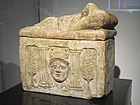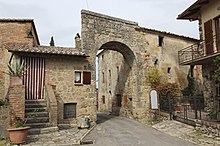Chiusi
| Chiusi | ||
|---|---|---|

|
|
|
| Country | Italy | |
| region | Tuscany | |
| province | Siena (SI) | |
| Coordinates | 43 ° 1 ' N , 11 ° 57' E | |
| height | 398 m slm | |
| surface | 58 km² | |
| Residents | 8,314 (Dec 31, 2019) | |
| Population density | 143 inhabitants / km² | |
| Factions | Chiusi Scalo, Montallese, Macciano, Querce al Pino | |
| Post Code | 53043 Chiusi città (capoluogo), 53044 Chiusi stazione (Chiusi Scalo), 53040 Montallese | |
| prefix | 0578 | |
| ISTAT number | 052011 | |
| Popular name | Chiusini | |
| Patron saint | Santa Mustiola and San Secondiano (July 3rd) | |
| Website | Chiusi | |
 Panorama of Chiusi |
||
Chiusi is an Italian city with 8314 inhabitants (as of December 31, 2019) in Tuscany and is located in the province of Siena between Lake Trasimeno and Lake Bolsena .
geography
The municipality is located about 60 km southeast of the provincial capital Siena and about 100 km southeast of the regional capital Florence . Italy's capital Rome is approx. 130 km south. Chiusi is in the climatic classification of Italian communities in zone D, 2 022 GG. Important waters in the municipality are the Torrenti Astrone (4 of 22 km in the municipality), Gragnano (7 of 7 km in the municipality), Montelungo (6 of 6 km in the municipality), Parce (5 of 13 km in the municipality) and Tresa (4 of 5 km in the municipality). The Torrenti Gragnano, Montelungo, Parce and Tresa belong to the Arno river system , the Astrone to the Tiber river system .
Its districts include Chiusi Scalo (252 m, approx. 3900 inhabitants), Montallese (266 m, approx. 560 inhabitants, partly also belongs to Montepulciano), Macciano (335 m, approx. 50 inhabitants), Montevenere (350 m, approx. 140 inhabitants) and Querce al Pino (328 m, approx. 50 inhabitants).
The neighboring municipalities are Castiglione del Lago ( PG ), Cetona , Chianciano Terme , Città della Pieve (PG), Montepulciano and Sarteano .
history
Antiquity
Chiusi, Etruscan Clevsin , Latin Clusium , goes back to Etruscan origins. Remains of huts and pottery finds go back to the end of the Bronze Age and Villanova culture , necropolises around the emerging city above the Chiana valley date from the Villanova period and the orientalizing epoch , chamber tombs first appeared at the end of the 7th century BC. At that time Clusium was already an important place in Etruria , center of agriculture, trade and industry, capital of an Etruscan city-state, member of the Etruscan League of Twelve Cities and probably ruled oligarchically . The 6th century BC represents an archaeologically tangible high point in the development of the place. Chr.
The Roman historiography also reports on Clusium. Then Lars Porsenna , king of the city, advanced on Rome after the fall of the Roman-Etruscan king Tarquinius Superbus (510 BC) , he besieged the city and probably also took it. From Rome, Porsenna is said to have tried to extend his rule over Latium , but his son Aruns Porsenna suffered a defeat before the Latin city of Aricia by the Latins and Greeks under the tyrant Aristodemos of Kyme (504/503 BC). The father then had to withdraw from Rome and probably returned to Clusium, where he probably died at the beginning of the 5th century.
To what extent the political setbacks of the 5th century BC ( Defeat of the Etruscans at Cumae , 474 BC) Chiusi influenced remains unclear. According to Roman historiography, the city was founded in the 4th century BC. Played a role in the Gauls invasion of central Italy: A Chiusin citizen named Arruns had led the Gauls to invade. Chiusi was attacked (390 BC), the inhabitants turned to Rome for help, the Roman ambassador Quintus Fabius Ambustus killed the leader of the Gauls, whereupon they turned against Rome. Archaeological is in the further course of the 4th century BC. A decay of Chiusiner power visible.
296/295 BC The Chiusin territory was the scene of the fighting between Romans, Etruscans, Gauls and Umbrians ( Battle of Sentinum ). In the period that followed, Chiusi was increasingly included in the Roman state , albeit with the preservation of its aristocratic-oligarchic order. In 205 BC In the 2nd Punic War (218 - 201 BC) the city took part in equipping the Roman army that was to be deployed against Carthage in North Africa .
After the Roman alliance war (91-89 BC), the Chiusins, now Roman citizens , were assigned to the Arnensis tribe . The Roman dictator Sulla (82 - 79 BC) founded a veterans' colony on Chiusin territory. Chiusi was now a Roman-Etruscan town in Italy, united under Roman rule, a traffic junction between the Arno and Tiber valleys , between the Tuscan coast and the hinterland.
middle Ages
From the 11th century Chiusi was under the rule of its bishops, later under the influence of Orvieto . In 1231 it came to Siena , 1556 to the Grand Duchy of Tuscany .
Population development

Attractions
Etruscan culture
In the area around Chiusi there are some Etruscan barrows . The Etruscan Museum is one of Italy's most important repositories for Etruscan culture.
- Etruscan objects found in Chiusi
Terracotta figure of an Etruscan woman ( Badisches Landesmuseum )
Double- faced kantharos (drinking vessel) ( Louvre )
Wine jug with a bull face ( National Archaeological Museum Florence )
Ash urn
1st century BC BC ( Ducal Museum Gotha )
Churches
- Concattedrale di San Secondiano , also called Duomo, co-cathedral in the diocese of Montepulciano-Chiusi-Pienza . The campanile was built in 1585 from a defensive tower . The building was built in the 6th century and underwent major changes in the 12th century. Further changes were made at the end of the 18th century. From 1887 to 1894, Giuseppe Partini restored the church. Inside it contains works by Arturo Viligiardi ( Santa Caterina che impara miracolosamente a leggere (Cappella della Madonna), La martire Orsola , Dormitio Virginis , Santa Caterina d'Alessandria and Sante e Santi martiri ) as well as a work by Bernardino Fungai ( Adorazione del Bambino tra i Santi Secondiano e Girolamo ).
- Chiesa di San Francesco , church in the town center on the town hall square. The church used to be part of a monastery operated by the Augustinian order .
- Chiesa di Santa Maria Novella , church in the center from the 11th century. The campanile was built later and emerged from a tower of the defensive wall. Was restored in 1902.
- Chiesa di Sant'Apollinare , church in the town center
- Chiesa di Santo Stefano , church in the town center
- Chiesa di Santa Maria della Pace , church built in 1925 in the Chiusi Scalo district.
- Chiesa del Santissimo Nome di Maria , church in the Querce al Pino district. The church was built in 1586 on the site of a tabernacle and first belonged to the Franciscans , then to the Jesuits , who stayed until 1621.
- Chiesa di San Piero Apostolo , church in the district of Macciano
- Chiesa di San Leopoldo , church in the Località Dolciano. Made in the 17th century.
More Attractions
- Fortezza (also called Rocca Paolozzi ), castle from the late 12th century.
- Porta Lavinia , formerly also called Porta alla Vigna , northern city gate, which still exists today and was built before the 14th century.
- Palazzo Comunale , town hall from the 15th century.
- Teatro comunale Pietro Mascagni , theater
- Lago di Chiusi , lake and nature reserve (Aree naturali protette diinterest locale (ANPIL))
traffic
- Chiusi is connected to the A1 ( Autostrada del Sole ) via the Chiusi-Chianciano Terme junction .
- In the district of Chiusi Scalo , the Chiusi-Chianciano Terme station is on the Florence-Rome high-speed line .
- The train station in the Montallese district was also connected to this route. He was also on the Empoli- Siena route .
Community partnerships
Chiusi has parish partnerships with:
- Andrézieux-Bouthéon , Loire department , France
- Neu-Isenburg , Germany
literature
- Giovannangelo Camporeale : The Etruscans. History and culture. Düsseldorf-Zurich 2003, pp. 398-415.
- Laura Martini (ed.): I Luoghi della Fede: Montepulciano e la Valdichiana senese. Arnoldo Mondadori Editore , Milan 1999, ISBN 88-04-46787-8 , pp. 144-154.
- A. Rastrelli: Chiusi. In: Enciclopedia dell'Arte Antica , 1994 (v. Vol. II, p. 559)
- Emanuele Repetti: CHIUSI in Val di Chiana (CLUSIUM, già CAMARS degli Etruschi). In Dizionario Geografico Fisico Storico della Toscana (1833–1846), online edition of the University of Siena (PDF, ital.)
- Touring Club Italiano : Toscana. Milan 2003, ISBN 88-365-2767-1 , pp. 752 ff.
Web links
- Website of the Chiusi Municipality
- Website of the Pro Loco in Chiusi
Individual evidence
- ↑ Statistiche demografiche ISTAT. Monthly population statistics of the Istituto Nazionale di Statistica , as of December 31 of 2019.
- ↑ Website of the Agenzia nazionale per le nuove tecnologie, l'energia e lo sviluppo economico sostenibile (ENEA), accessed on June 15, 2015 (Italian) (PDF; 330 kB)
- ↑ Official website of the Sistema Informativo Ambientale della Regione Toscana (SIRA) on the rivers in Chiusi , accessed on June 15, 2015 (Italian)
- ↑ Official website of the Istituto Nazionale di Statistica (2001, Italian), accessed on June 15, 2015 (Italian)
- ↑ a b c d Laura Martini (ed.): I Luoghi della Fede: Montepulciano e la Valdichiana senese.
- ↑ A. Rastrelli
- ^ A b Touring Club Italiano: Toscana.
- ↑ Porta Lavinia, già Porta “ala Vigna” , website of the Gruppo Archeologico “Città di Chiusi”, accessed on June 19, 2015 (Italian)












